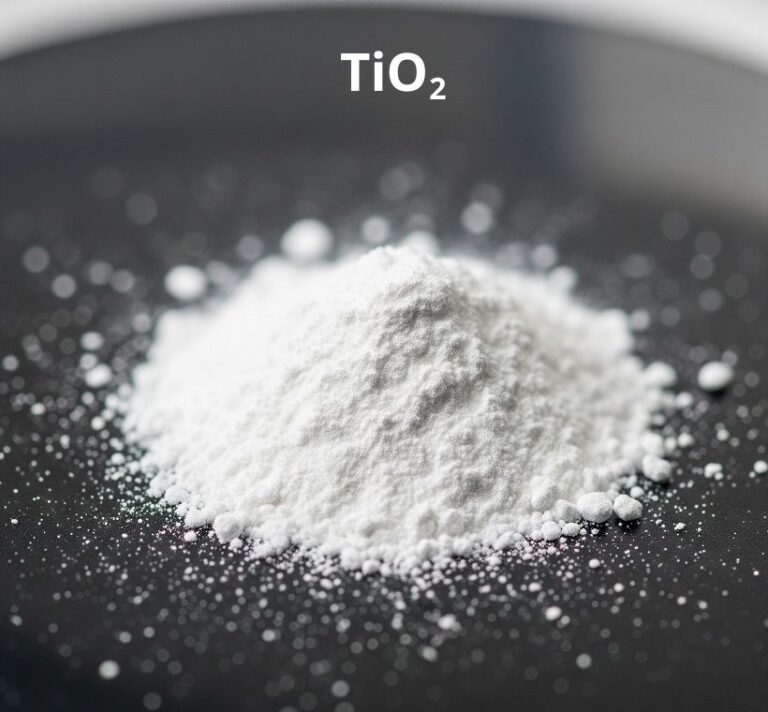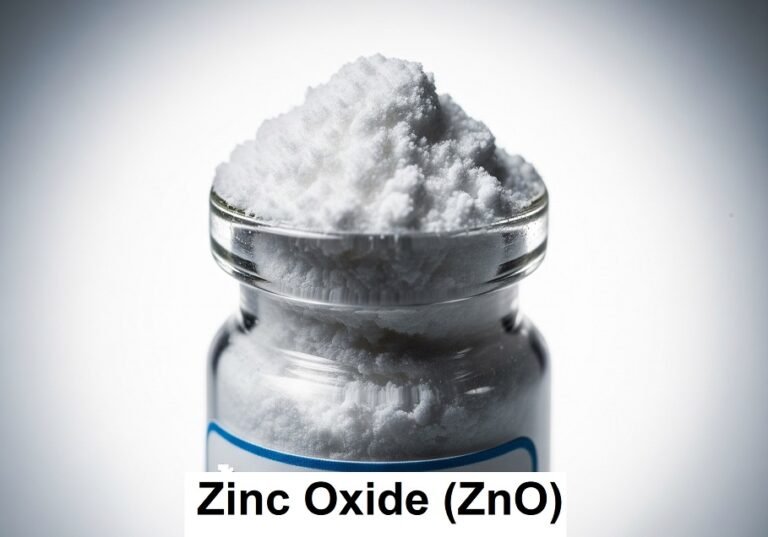
Aluminates are metal salts of alumina (aluminum oxide, Al2O3). The most important aluminates in industry are sodium aluminate and barium aluminate.
Table of Contents
1. Sodium Aluminate
Sodium aluminate is an important commercial inorganic chemical. It is an effective source of aluminum hydroxide for many industrial and technical applications. Commercial grades of sodium aluminate are available in solid and liquid forms.
Pure sodium aluminate (anhydrous) is a white crystalline solid with the formula NaAlO2. Commercial grades, however, always contain more sodium oxide (Na2O) than the stoichiometric amount required. The excess sodium oxide is typically on the order of 1.05 to 1.50 times the formula requirement. Hydrated forms of sodium aluminate are crystallized from concentrated solutions.
Sodium aluminate has no defined melting point. It softens above 1700 °C when sodium begins to evaporate slowly, leaving aluminum oxide.
1.1. Production of Sodium Aluminate
The primary commercial method for producing sodium aluminate is the dissolution of aluminum hydroxides in a sodium hydroxide solution. Aluminum trihydroxide, obtained from the Bayer process (also known as Aluminum Oxide), can be dissolved in aqueous NaOH solutions ranging from 10% to 30% concentration. This dissolution occurs at temperatures close to the boiling point.
Employing more concentrated NaOH solutions results in a semisolid product. The procedure is conducted within steam-heated vessels constructed from nickel or steel. The aluminum hydroxide is boiled with around 50% aqueous sodium hydroxide until a pulpy consistency forms.
Following this, the mixture is transferred to a tank for cooling, leading to the formation of a solid mass containing approximately 70% NaAlO2. Once crushed, this solid mass undergoes dehydration in a rotary oven, either directly or indirectly heated by hydrogen combustion.
The end product comprises roughly 90% NaAlO2, 1% water, and an additional 1% of free NaOH. The solubility characteristics of the resultant salt depend significantly on the extent of excess sodium hydroxide used.
As an alternative, bauxite can serve directly as the source of alumina. Bauxites containing gibbsite are extracted under conditions of 150 °C and 5 bar pressure. However, bauxite containing boehmite necessitates higher temperatures (230 °C) and pressures.
The sodium aluminate solution obtained from the digestion process is isolated from impurities and then concentrated for the production of the commercial liquid grade by evaporation. The solid product is derived from the drying of this liquid mixture.
An additional method used for sodium aluminate production is the sintering technique. This involves sintering sodium carbonate directly with Bayer aluminum trihydroxide in rotary sintering kilns operating at 1000°C. The outcome is an essentially anhydrous product. When sintering bauxite, a crucial step is leaching the sintered mass with water to separate the impurities.
1.2. Uses of Sodium Aluminate
Sodium aluminate finds diverse applications, making significant contributions across multiple domains. It is used in water treatment, construction technology, catalysis, and beyond. The versatile attributes of sodium aluminate render it an indispensable compound in modern industrial practices.
Water Treatment
Sodium aluminate has a central application in water treatment for both potable and industrial waters. As an adjunct to water softening systems, it enhances flocculation and aids in the removal of dissolved silica.
When dissolved in water, sodium aluminate gives a solution with a pH value of 8. This solution facilitates the precipitation of aluminum hydroxide, which boasts exceptional flocculation properties, effectively coagulating impurities present in the water.
For optimal results, the addition of aluminum sulfate can further refine the conditions of precipitation, depending on the specific impurities in question.
Construction Advancements
In the construction technology, sodium aluminate is used to accelerate the solidification of concrete, particularly in challenging conditions such as frost, underwater applications, and humid soil.
When compared to calcium chloride, sodium aluminate has an advantage in achieving rapid setting acceleration, particularly at low water-to-cement ratios. Notably, its compatibility with steel-reinforced concrete, without causing detrimental effects on reinforcing metals, adds to its appeal.
Additions of substances such as oxoacids, sugar, naphthene, K2CO3, or Na2SO4 can bolster final strength without substantially affecting the setting rate. Sodium aluminate not only reinforces resistance to water, alkali, and acid in mortar but also plays a role in the production of expanded concrete by activating nitrogen-releasing substances.
Furthermore, its addition stabilizes foam formation in the production of light refractory bricks, where up to 5% sodium aluminate (relative to the total dry mass) is incorporated.
Wide-Ranging Applications
Sodium aluminate has become increasingly integral in the production of synthetic zeolites, serving as both catalyst support and catalyst. It is the principal source of alumina for the preparation of alumina adsorbents and catalysts.
It is used in the paper industry for enhancing opacity, fiber and filling material retention, and paper strength. Also, it stabilizes pH values in water circulation and bolsters the dispersion stability of titanium dioxide.
Another application involves the use of sodium aluminate as a pickle to safeguard metallic surfaces of copper, aluminum, or other materials.
This safeguarding effect is based on the formation of a thin and firmly adhering layer of aluminum hydroxide or, post-heat treatment, aluminum oxide on the surface, preserving the metallic luster.
The enamel industry benefits from the incorporation of sodium aluminate into enamel mixtures to achieve low-melting covers.
Sodium aluminate’s influence continues to grow in fields like lithography for the production of printing inks and print forms, as well as in the detergent and varnish industries.
It contributes to the creation of water-insoluble floor waxes and serves as a dispersion agent for the production of high-purity asbestos. It also finds applications in drilling fluids, textiles as a mordant in dyeing and printing cloth, and numerous other domains.
Its capabilities include inhibiting glass etching by alkaline solutions, safeguarding steel surfaces during galvanizing, enhancing dyeing and antistatic properties of polyester synthetic fibers, and acting as an additive in foundry sand molds and cores. Moreover, it finds a role as a binder in the ceramics industry, cementing its significance across the industrial landscape.
2. Barium Aluminates
Barium aluminates are compounds of barium and aluminum oxides. The most important industrially are BaO·6 Al2O3 (melting point 1915 °C), BaO·Al2O3 (melting point 1815 °C), and 3 BaO·Al2O3 (melting point 1425 °C). The first two crystallize in the hexagonal crystal system.
Barium aluminates are produced by melting bauxite with coal and barite. The melt is leached to give a solution of barium aluminate, from which the salt is obtained by evaporation. Very pure barium aluminates can be produced by sintering mixtures of aluminum oxide with barium carbonate.
All barium aluminates, including hydrated compounds such as BaO·Al2O3·4 H2O, 2 BaO·Al2O3·5 H2O, BaO·Al2O3·7 H2O, and 7 BaO·6 Al2O3·36 H2O, hydrolyze in water, forming gibbsite (Al(OH)3) and relatively soluble barium hydroxide.
Barium aluminates are used for purifying water because the Ba2+ ion precipitates both sulfates and carbonates, whereas the aluminate ions form insoluble calcium aluminate.
They are also used as a special cement, for example, as a binding agent for the production of high-temperature refractories, and in the production of radiation shields.
Reference
- Aluminum Compounds, Inorganic; Ullmann’s Encyclopedia of Industrial Chemistry. – https://onlinelibrary.wiley.com/doi/10.1002/14356007.a01_527.pub2
FAQ
The chemical formula for aluminate is typically expressed as MAlO2 or M2Al2O4, where M represents a metal cation, often sodium (Na) or barium (Ba).
In chemistry, aluminate is a compound that contains the aluminate anion (AlO2–). It can be found in a variety of forms, including solid, liquid, and gas.
Sodium aluminate is basic in nature. When dissolved in water, it produces hydroxide ions (OH–) that contribute to its alkaline properties.
Sodium aluminate is made by dissolving aluminum hydroxide in sodium hydroxide solution. Additionally, bauxite, a source of aluminum, can be treated with sodium hydroxide to obtain sodium aluminate.
Sodium aluminate finds various applications, including water treatment for softening and coagulation, concrete solidification acceleration, catalyst support, and in the production of synthetic zeolites. It also enhances paper opacity, serves as a mordant in textiles, and has uses in the enamel industry, among others.
Sodium aluminate is used as a coagulant due to its ability to aid in the aggregation and removal of suspended particles and impurities in water. It promotes flocculation, which simplifies the process of separating impurities from water.
Sodium aluminate is sometimes referred to as sodium aluminum oxide or sodium aluminumate.
When sodium aluminate reacts with water, it produces a strong alkaline solution by the formation of hydroxide ions (OH–) and alumina hydrate. The pH of the solution can be as high as 13.



